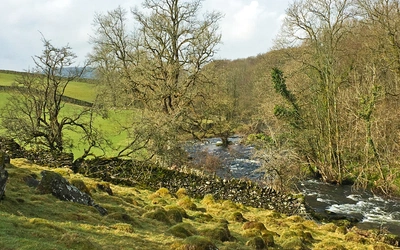The Cicerone Story
For over 50 years, Cicerone has been helping adventurers find their way — through valleys and over mountain passes, across quiet moorland paths and along windswept coastlines. We have over 400 guidebooks for walkers, trekkers, climbers and cyclists, all trusted companions crafted by people who know and love the landscapes you long to explore. Here is our story in a nutshell.
Where our journey began
The word Cicerone means ‘a guide,’ someone who reveals the mysteries and wonders of a place. That’s precisely what Cicerone has been doing since 1969, when climbers Walt Unsworth and Brian Evans, frustrated by the lack of quality guides, decided to publish their own pocket-sized guidebooks — written by people who knew the routes inside out.
The first guidebook on the Northern Lake District was just 40 pages long, complete with hand-drawn illustrations, and printed on a small press in Brian’s garage. It was small but mighty and set in motion a legacy that would inspire generations of adventurers.
A family tradition
In 1999, Jonathan and Lesley Williams took over Cicerone, bringing fresh eyes, boundless enthusiasm and a shared love of the outdoors. What they lacked in publishing experience, they made up for in curiosity and determination and learnt every aspect of book production from scratch.
From their early days juggling sales trips, map design and marketing on a shoestring, to building a dedicated team of editors and designers, the Williamses ensured Cicerone remained true to its roots while growing in reach and ambition.
It wasn’t always smooth — within two years, the outbreak of foot-and-mouth disease closed Britain’s countryside and sales plummeted — but Cicerone weathered the storm, strengthened by the loyalty of authors and readers.
In 2023, their son Joe and daughter Madeline took over. Under their leadership, Cicerone has continued to flourish as a proudly independent, family-run publisher, producing guidebooks trusted by walkers, trekkers and climbers across the world.
Over Cicerone’s lifetime, the publishing world has changed beyond recognition — from small independent bookshops to global retailers, from hand-crafted pages to digital printing, from printed maps to maps on phones, from ferries and currency limits to low-cost airlines, and from the strikes of the 1970s through Thatcherism, austerity, EU membership and Brexit.
Despite all the change, the essentials remain unaffected. Cicerone’s mission is still to inspire and guide adventures ‘out there’ and to provide a great time on the hill, trail, trek, cycle or climb.
— Jonathan Williams, Chairman
From the Lakes to the world
Cicerone’s roots remain in the mountains and landscapes of Britain (the team are based in Kendal on the edge of the Lake District), but the list now stretches to the Alps, the Andes, the Himalaya, Patagonia and beyond. Whatever the destination, the mission is unchanged: to inspire adventure and provide trusted companions for a great day out on the hill, trail, trek or climb.
Every guide begins with an author who knows their region intimately. Together, we walk, cycle and check every route, refine the mapping, and polish every detail so you can explore with confidence. Today, our library of over 400 guidebooks covers:
- Day walks and long-distance trails
- Pilgrim trails
- Trekking and mountaineering
- Scrambling, climbing, via ferrata and winter climbs
- Cycling routes from family rides to epic tours
- Short and easy day walks
- Outdoor skills
Each guide is pocket-sized yet rich with detail, with crystal-clear mapping, precise route descriptions, and expert insights from authors who know and love their regions. Around 30 titles are published or fully updated every year, ensuring every route is accurate and reliable.
Creating a great guide is a challenge — it takes deep knowledge and love of an area, skill in choosing routes, writing, photography, mapping and digital work, and the ability to bring it all together so the author’s personality shines. The author is the parent of a guide; as publisher, we are its guardians, and success depends on harmony between the two. Authors are the foundation, but many others play a part — editors, designers, sales and marketing, finance, copyeditors, freelancers, mapping partners, printers, distributors. It’s a team effort, and we have a great team.
— Jonathan Williams, Chairman
Looking ahead
Cicerone has been guiding adventures for over 50 years, from Britain’s best-loved paths to epic treks across the world. Today, we continue to evolve, embracing new technology while staying true to the values that have defined us since 1969: family-run, rooted in the Lake District, and dedicated to creating the most trusted guides for generations of adventurers.
Our mission remains simple: to inspire adventure, provide essential information, and support explorers wherever they go. From the hand-drawn maps of our first guides to cutting-edge digital tools, we’re proud to continue guiding your adventures every step of the way.
Our values
- Trusting — built on decades of expertise, our guides are relied on by walkers, trekkers, and climbers across the world.
- Caring — we look after our readers, authors, and team, always putting people and the outdoors at the heart of what we do.
- Improving — from hand-drawn maps to digital navigation, we’re always seeking better ways to guide adventures.
- Adventuring — we live what we publish: every route, trek, and climb is shaped by genuine love of the outdoors.
So, where will your next adventure take you?



